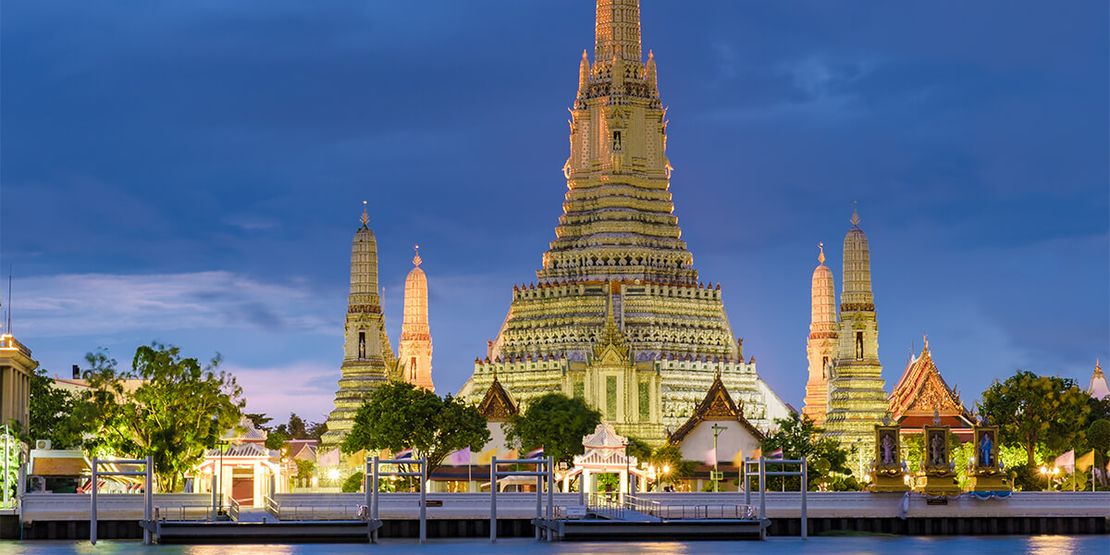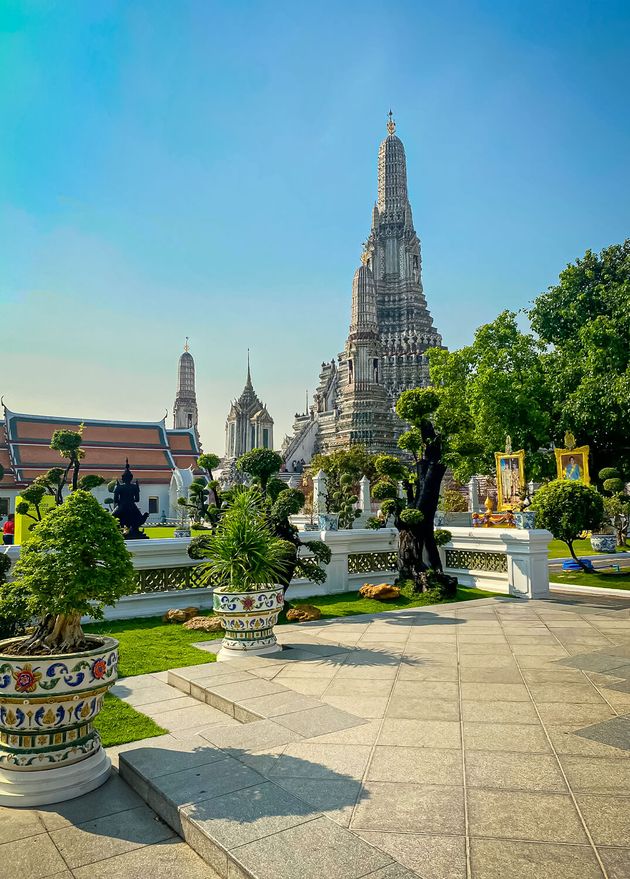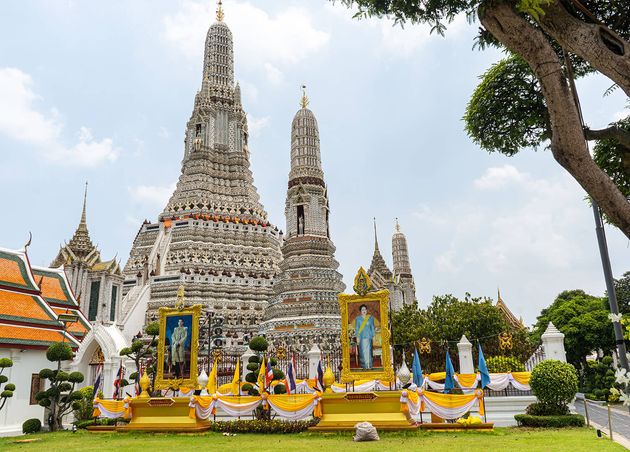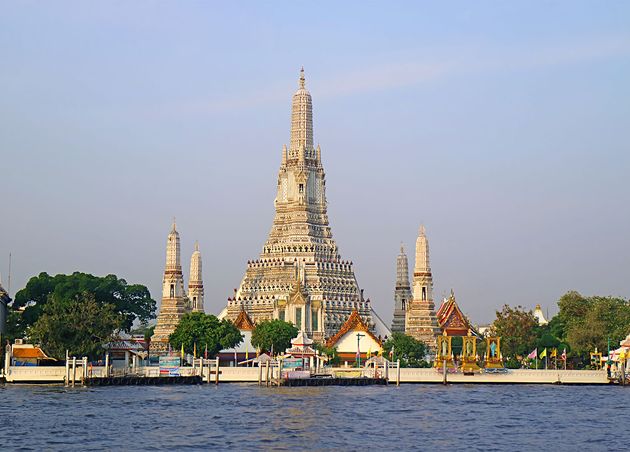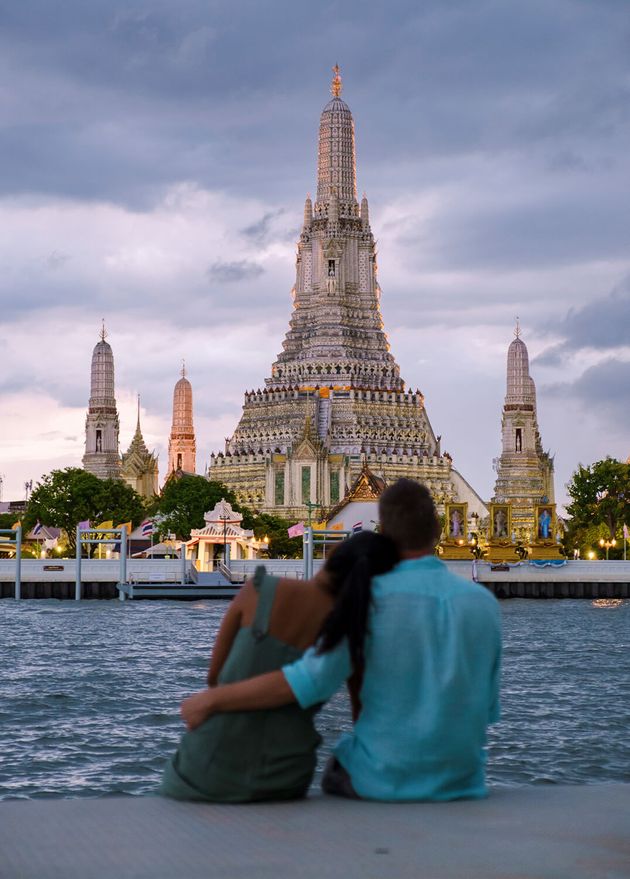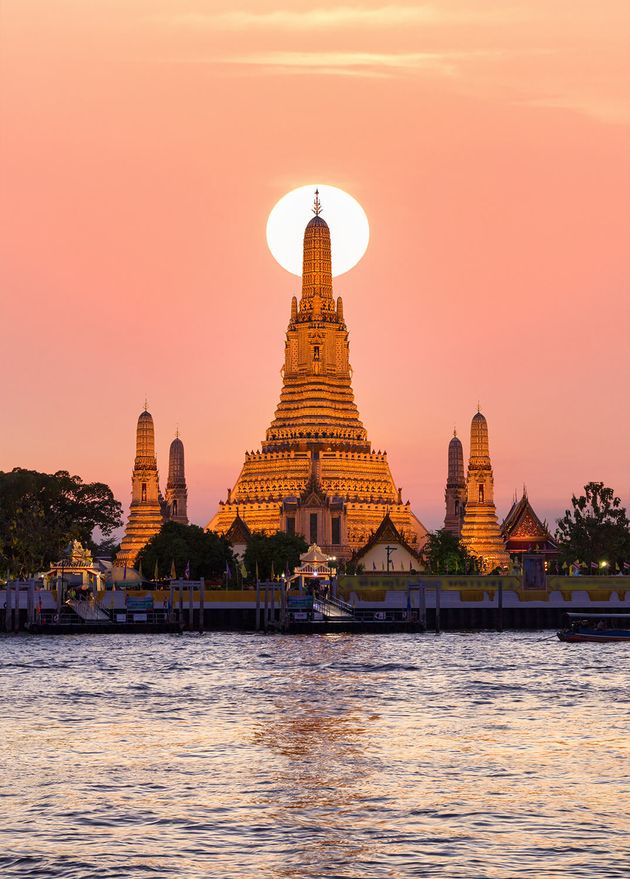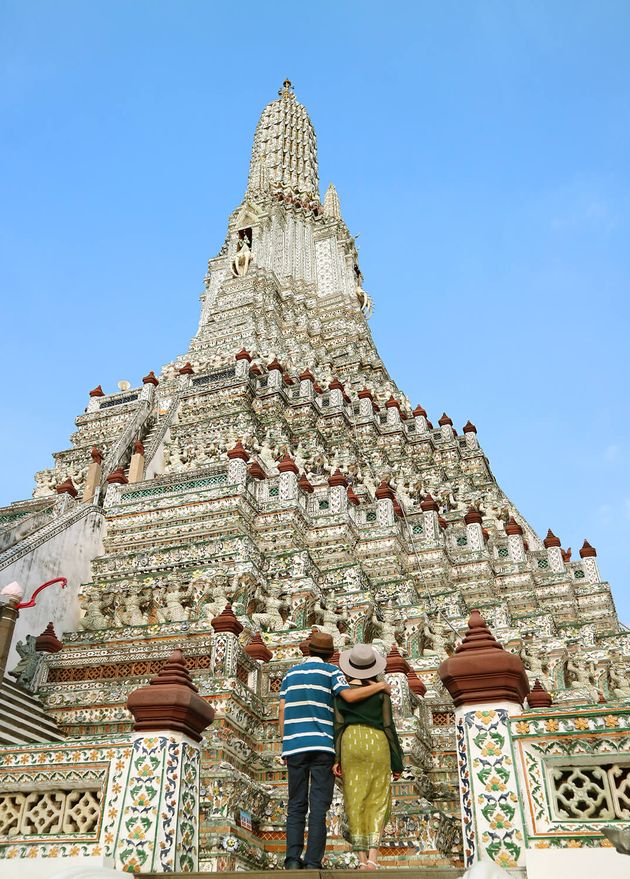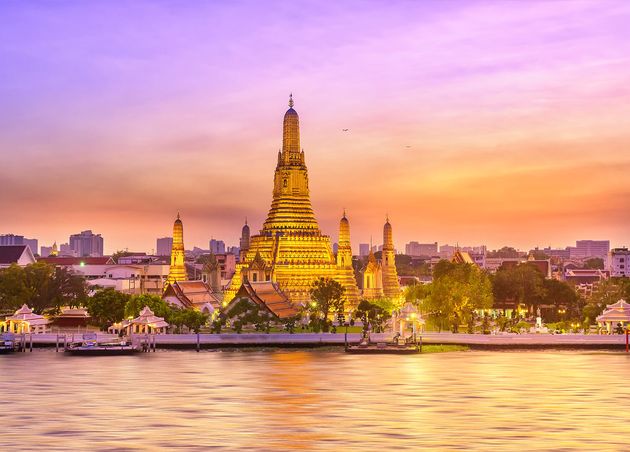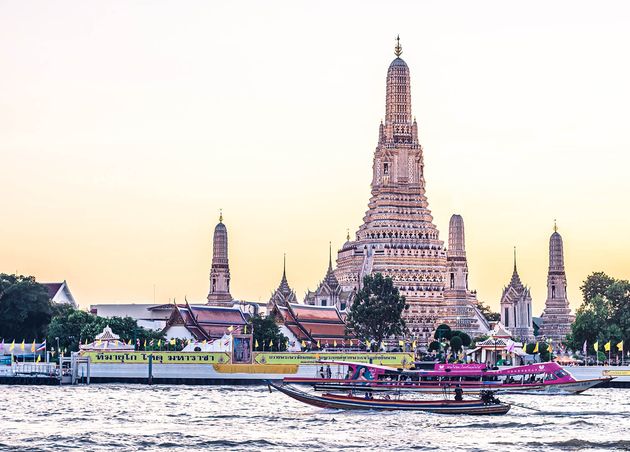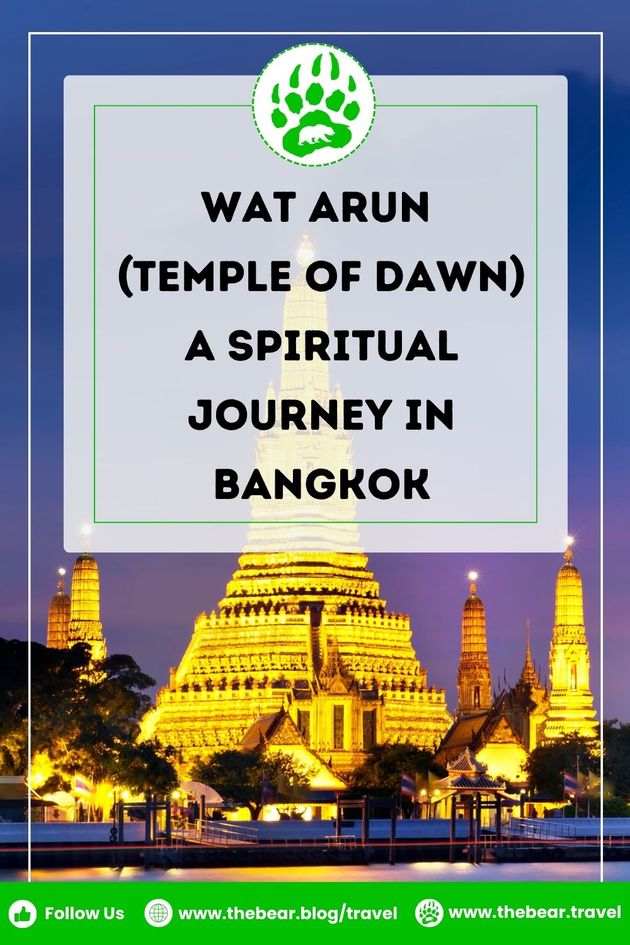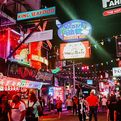Wat Arun (Temple of Dawn): A Spiritual Journey in Bangkok
When it comes to the must-see temples in Thailand, Wat Arun in Krung Thep Maha Nakhon (Bangkok) is the place on everyone's bucket list. It is similarly known as the Temple of the Dawn and is placed on the western side of the Chao Phraya River. Due to its exquisite architecture and the most iconic setting on the river, a stop is a must on every planned Thailand trip.
In addition, Wat Arun (Temple of Dawn) is a highly respected ancient temple in Thailand. Everyone has seen at least one of the traditional riverside landscapes seized with Wat Arun, whether in the morning or a lovely light up in the evening.
Wat Arun is impressively scenic due to its distinctive architecture, and its primary riverside location also broadens its attraction.
We indeed bet you'll have the time of your life there and hope now you feel the need to go there, don't you? Then read on!
To make your visit to Wat Arun perfect, you should plan your time carefully, as the temple sections are extensive. There are many beautiful buildings, pavilions, and sculptures for you to see. So the best time to visit is early morning or late afternoon, which has the most relaxed and beautiful atmosphere.
The Architectural Splendor of Wat Arun
The leading and most prominent structure of Wat Arun is the Phra Prang Wat Arun, which overlooks the Chao Phraya River. It is one of the world's remarkable landmarks and one of Thailand's most photographed icons.
Initially constructed during the Ayutthaya Period, King Rama II initiated its reconstruction and expansion, with the project completed during King Rama IV's reign and under King Rama IV changed its official name to Wat Arun Ratchawararam. The Phra Prang Wat Arun stands at an impressive 82 meters in height and was the tallest structure in Bangkok until modern skyscrapers emerged. The prang and its four satellite prangs are adorned with colorful porcelain pieces imported from China.
Surrounding the Phra Prang Wat Arun are multiple levels of balconies. Tourists can climb these levels to enjoy breathtaking views of the Chao Phraya River, the Grand Palace, Wat Pho, downtown Bangkok, and other nearby landmarks. Additionally, visitors can explore the main temple, the hall, and the Chinese-style bell tower, all equally stunning and worth a visit.
Respectful Visits to Wat Arun in Bangkok
Standing proudly on the banks of the mighty Chao Phraya River, Wat Arun is a must-visit site in Krung Thep Maha Nakhon (Bangkok) and a source of significant cultural inspiration.
Frequently referred to as the Temple of Dawn, the exquisite Wat Arun is one of Bangkok's most famous temples. Construction of this magnificent structure began in the 17th century, and it was originally named Wat Arun Dhamma Sathan. It features a stunning Khmer-style tower that stands at approximately 82 meters in height. At one point in history, the famous Emerald Buddha was enshrined here.
Situated across from Wat Pho, Wat Arun is a breathtaking sight at dawn and sunset. Thanks to its riverside location, one of the best ways to appreciate its beauty is by taking a boat tour along the Chao Phraya River, particularly at night when it is illuminated and radiates like a beacon along the "River of Kings."
Climbing to the top of the central tower awards visitors spectacular panoramic views of the surrounding landscape, including the river, Wat Pho, and the Grand Palace. Wat Arun's distinct image is widely recognized and featured on the 10 THB coin and the Tourist Authority of Thailand (TAT) logo.
Sightseeing Wonders at Wat Arun
Set aside one late afternoon to see and take a picture of this incredible sight at sunset with the stunning Chao Phraya River in the foreground. These snapshots will bring back beautiful recollections of Krung Thep Maha Nakhon (Bangkok).
As one of the most significantly essential temples in Thailand's history, Wat Arun has many outstanding glamours in Krung Thep Maha Nakhon (Bangkok), mainly the central prang, a stupa-like pagoda crusted with brilliantly coated porcelain tiles and seashells giant monuments, the Ordination Hall as well as the Bell Tower, and many other Buddha sculptures.
- Entrance to the Ordination Hall
- The corridor to the temple is a famous arch. You can take unbelievable pictures of Wat Arun.
- What's more? Two massive, ornately decorated giant statues enter the priest's ordination room.
- Getting there early in the morning is recommended; you'll have this fantastic area.
- Main Temple
- It is supposedly the most spiritual part of Wat Arun.
- The beautiful walkway with Buddha statues made us love this beautiful temple. It is also considered one of the most fascinating places in Bangkok!
- Another highlight of the temple is its marble yard. Multiple Chinese stone carvings illustrate lions, dragons, soldiers, and other statues.
- Phra Prang Hall
- Wat Arun is well-known for the beauty of the 70-meter-tall Prang Hall, a Lanka-style chedi.
- One can even discover the pagoda shining luminously at noontime, even from an extent.
- This white temple has beautiful porcelain and shell mosaics comprising thousands of floral patterns.
- The Great Prang of Wat Arun
- It is regarded as the most glamorous and impressive art, designed by skillful craftsmen.
- The pagoda is decorated with porcelain and Benjarong pottery from China, which has beautiful patterns.
- These old and unique items were restored until the reign of King Rama V.
- Area Around the Great Prang of Wat Arun
- It consists of 4 small pagodas in four directions. Inside, there is an image of Indra on the Erawan elephant.
- A glass wall separates Thaksin's base three levels with monuments of devils that hold swords on alternate bases.
- In addition, there are four arches with Vishnu incarnations.
- Sunset at Wat Arun
- It's an adventure that you can't skip or experience anywhere else with the sunset at Wat Arun.
- On the opposite side of the river, you'll discover several rooftop bars where you can get the best view of the temple.
- Wat Arun is fantastic to see when the temple is lit at night.
The name of this Buddhist temple, Wat Arun, is inspired by the Hindu God Aruna, who is associated with the reddish glow of the rising sun. As the sun ascends each morning, its radiant light reflects off the temple's surfaces, giving it a captivating and luminous appearance. This is the reason behind its renowned moniker, the "Temple of Dawn."
Captivating View from the Chao Phraya River
Consider taking a Chao Phraya River tour for a stunning view of Wat Arun and the perfect photo spot. In the daytime, the temple's impressive spire gleams brilliantly under the sunlight, creating a picturesque scene against the blue sky.
At sunset, Wat Arun takes on a different character. The setting sun casts its warm glow on the spire, creating a more subdued and mystical atmosphere. This transition from day to night at Wat Arun is a sight to behold and offers excellent opportunities for photography.
What to Know Before Visiting Wat Arun in Bangkok?
Here are some additional details and tips for visiting Wat Arun:
-
Suggested Time
-
As mentioned, visiting Wat Arun in the morning or evening is best when the weather is more pleasant, and the temple is beautifully illuminated during sunrise and sunset.
-
-
Admission Fee
-
The entrance is free for Thai citizens, while foreigners are charged an admission fee of 50 THB. Please note that fees may change, so checking in advance is a good idea.
-
-
Opening Hours
-
The temple is usually open daily from 8 a.m. to 6 p.m., but verifying the hours before your visit is a good idea.
-
-
Dress Modestly
-
Visitors planning to enter the central prang should ensure they are dressed modestly. Wear comfortable clothing that covers your shoulders, arms, and knees. You can also rent or purchase appropriate attire near the temple.
-
-
Stairs and Footwear
-
Be cautious when climbing the temple's steep and narrow stairs. Before entering the temple, you must remove your shoes, so consider wearing easily removable footwear. Socks can be comfortable as the polished tile floors can become hot during the day.
-
-
Duration of Visit
-
Plan to spend at least 30 minutes to an hour exploring Wat Arun. You can enjoy the view, take photos, and explore the temple grounds at your own pace.
-
-
Parking
-
There are parking facilities available within the vicinity.
-
-
Road Conditions
-
Be aware that some roads to Wat Arun can be rough, and low-loaded trucks may have difficulty navigating the hilly terrain.
-
-
Activities
-
While at Wat Arun, you can participate in various activities, including paying respects to monks, making merit, and admiring the religious and architectural aspects of the temple.
-
Why Visit Wat Arun (Temple of Dawn) in Bangkok?
Visiting Wat Arun is believed by Thai people to bring about a "marvelous every night" life. As such, the temple is on the list when planning a pilgrimage to Bangkok's renowned temples. For those who cherish dharma practice, Wat Arun provides a serene retreat. Its tranquil ambiance, abundant natural surroundings, exquisite architecture, and sacred landmarks make it an appealing destination. Furthermore, it holds the distinguished status of a royal temple.
Being one of Bangkok's most iconic temples, Wat Arun stands out for its grand architecture and monumental significance in its history. A visit to this temple promises many beautiful photography opportunities, particularly along the Chao Phraya River, with its distinctive vertical staircases and undulating architecture. Wat Arun isn't just a tourist attraction; it's a fully functional Buddhist temple where you can perform rituals with the resident monks. These experiences can be life-changing and profoundly moving.
Given Wat Arun's popularity, it's advisable to arrive early, preferably in the morning around opening hours, to avoid the crowds. While you can visit anytime, arriving early ensures a more peaceful and less crowded environment, enhancing your chances of capturing exquisite photos.
How to Wat Arun (Temple of Dawn) in Bangkok?
Wat Arun is situated on the western bank of the Chao Phraya River, which is directly across from Wat Pho. There are multiple ways to access this iconic temple: by road and boat.
You can reach Wat Arun via Amarin Road if you prefer to take the road. Another option is to arrive by boat from Than Tien Pier near Wat Pho. This pier is situated at the southwest corner of the Grand Palace, and you'll find frequent boat services operating here. To reach this pier, you can travel from other piers or take a taxi or bus ride.
For those traveling by car, simply head to Arun Amarin Road from Pinklao Road. Continue along this road, passing by Siriraj Hospital, until you reach the entrance to Wat Arun near the Naval Dockyard Department.
The Chao Phraya River flows through Bangkok, dividing it into two parts. Many well-known temples are located on the east bank, whereas Wat Arun lies on the west bank. Its beautiful towering spire is one of the landmarks of Bangkok.
Maps & More Information
Wat Arun Temple (Wat Arun Ratchawararam Ratchawaramahawihan; Temple of Dawn) is one of the most incredible temples in Thailand, located on Thonburi's west bank of the Chao Phraya River which is in the Yai District. Wat Arun Temple is a remarkable and beautiful place that holds significance in Thailand's history and showcases gorgeous architecture.
|
Entrance Fees |
Free for Thai Nationals |
|
Business Address |
158 Thanon Wang Doem, Wat Arun, Bangkok Yai, Bangkok 10600 |
|
Business Hours |
08:00 - 18:00 | Monday to Sunday |
|
Phone Number |
+66 (0) 2-891-2185 |
|
Email Address |
|
|
|
|
|
GPS |
13.7438652, 100.488444 |
The Bear Team
We, The Bear Team, are a united group of digital experts and adventurers. Combining technical skills with creative flair, we deliver informative, valuable, up-to-date content. Whether seeking travel inspiration or innovative solutions, we're your go-to for fun, authentic, impactful, and timeless experiences.
The Bear Travel | Experience like a Local
A fast-growing Thailand Travel Blog written by Expats and Thais since 2017. We will share our experiences and ideas from an insider point of view for you to create your own unique Thailand experience.
For the latest news and events about The Bear Travel, follow us on Facebook, Instagram, Twitter, Pinterest, or YouTube.
For any issues, concerns, or queries, don’t hesitate to CONTACT us.
Recommended for you
Thailand Travel Precautions: Recognizing Diseases and Animal Risks
Dr. Theodore (Professor Bear)
Thailand Permanent Residency and Citizenship Application: A Step-by-Step Guide
Dr. Theodore (Professor Bear)


